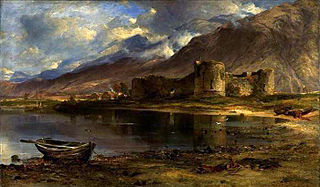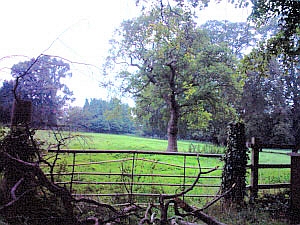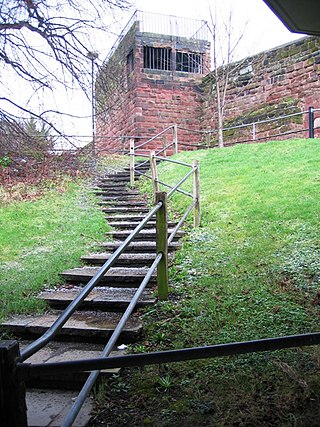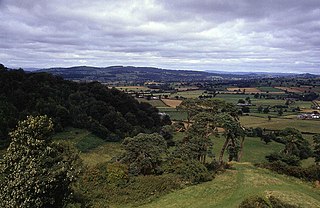
The Battle of Marston Moor was fought on 2 July 1644, during the Wars of the Three Kingdoms of 1639–1653. The combined forces of the English Parliamentarians under Lord Fairfax and the Earl of Manchester and the Scottish Covenanters under the Earl of Leven defeated the Royalists commanded by Prince Rupert of the Rhine and the Marquess of Newcastle.

The Battle of Naseby took place on 14 June 1645 during the First English Civil War, near the village of Naseby in Northamptonshire. The Parliamentarian New Model Army, commanded by Sir Thomas Fairfax and Oliver Cromwell, destroyed the main Royalist army under Charles I and Prince Rupert. The defeat ended any real hope of royalist victory, although Charles did not finally surrender until May 1646.

Marmaduke Langdale, 1st Baron Langdale was an English landowner and soldier who fought with the Royalists during the Wars of the Three Kingdoms.

The Battle of Philiphaugh was fought on 13 September 1645 during the Wars of the Three Kingdoms near Selkirk in the Scottish Borders. The Royalist army of the Marquis of Montrose was destroyed by the Covenanter army of Sir David Leslie, restoring the power of the Committee of Estates.

The Battle of Inverlochy occurred on 2 February 1645, during the Wars of the Three Kingdoms, when a Royalist force of Highlanders and Confederate Irish troops under the overall command of James Graham, 1st Marquess of Montrose, routed and largely destroyed the pursuing forces of Archibald Campbell, 1st Marquess of Argyll, who had been encamped under the walls of Inverlochy Castle.
The Battle of Tippermuir was the first battle James Graham, 1st Marquis of Montrose, fought for King Charles I in the Scottish theatre of the Wars of the Three Kingdoms. During the battle, Montrose's Royalist forces routed an army of the Covenanter-dominated Scottish government under John Wemyss, Lord Elcho. The government side took heavy losses.

Between 1639 and 1652, Scotland was involved in the Wars of the Three Kingdoms, a series of conflicts which included the Bishops' Wars, the Irish Rebellion of 1641, the English Civil War, the Irish Confederate Wars and finally the conquest of Ireland and the subjugation of Scotland by the English New Model Army.

Sir John Urry, also known as Hurry, was a Scottish professional soldier who at various times during the Wars of the Three Kingdoms fought for Scots Covenanters, Engagers and Royalists, as well as both English Parliamentarians and Royalists. Captured at Carbisdale in April 1650, he was executed in Edinburgh on 29 May 1650.

The Battle of Aberdeen, also known as the Battle of Justice Mills and the Crabstane Rout, was an engagement in the Wars of the Three Kingdoms which took place outside the city of Aberdeen on 13 September 1644. During the battle, Royalist forces led by James Graham, Lord Montrose routed an army raised by the Covenanter-dominated Parliament of Scotland under Robert Balfour, 2nd Lord Balfour of Burleigh.
The Battle of Auldearn was an engagement of the Wars of the Three Kingdoms. It took place on 9 May 1645, in and around the village of Auldearn in Nairnshire. It resulted in a victory for the royalists, led by the Marquess of Montrose and Alasdair MacColla, over Sir John Urry and an army raised by the Covenanter-dominated Scottish government.

The Battle of Kilsyth, fought on 15 August 1645 near Kilsyth, was an engagement of the Wars of the Three Kingdoms. The largest battle of the conflict in Scotland, it resulted in victory for the Royalist general Montrose over the forces of the Covenanter-dominated Scottish Parliament, and marked the end of General William Baillie's pursuit of the Royalists.
The Battle of Alford was an engagement of the Scottish Civil War. It took place near the village of Alford, Aberdeenshire, on 2 July 1645. During the battle, the Royalist general James Graham, 1st Marquess of Montrose defeated the forces of the Covenanter-dominated Scottish government, commanded by William Baillie.

Sherburn in Elmet is a town and civil parish in the district and county of North Yorkshire, England. It is to the west of Selby and south of Tadcaster.

The Battle of Rowton Heath, also known as the Battle of Rowton Moor, occurred on 24 September 1645 during the English Civil War. The Parliamentarians, commanded by Sydnam Poyntz, inflicted a significant defeat on the Royalists under the personal command of King Charles I, inflicting heavy losses and preventing Charles from relieving the siege of Chester.
The Battle of Annan Moor took place during the Scottish civil war, part of the intertwined Wars of the Three Kingdoms that took place in England, Ireland, and Scotland between 1639 and 1651.
1645 was the fourth year of the First English Civil War. By the beginning of 1645 the war was going badly for Charles I and the campaigns of 1645 did not see a recovery in his prospects.

The siege of Chester occurred over a 16-month period between September 1644 and February 1646 during the First English Civil War. In the engagement, Sir William Brereton and the Parliamentarians were ultimately successful in taking possession of the city and Royalist garrison commanded by Lord Byron.

The Battle of Montgomery took place during the First English Civil War of 1642–1646. On 17 September 1644, a Parliamentarian force commanded by Sir John Meldrum advanced to engage a Royalist army led by Lord Byron which was besieging Montgomery Castle in mid Wales. The battle was fought the next day. After the Royalists gained an initial advantage, the Parliamentarians counter-attacked and destroyed Byron's army.
Colonel John Cockburn was an officer in the Scottish Covenanter army in the late 1640s and early 1650s during the Wars of the Three Kingdoms. In this capacity he led Lowland soldiers against Montrose's Scottish Royalist forces during the First English Civil War (1642-1646), when the Covenanter parliament of Scotland was allied with the English Parliamentarians against King Charles I. Colonel Cockburn led the colourfully defiant but futile Scottish resistance at Hume Castle during the Third English Civil War (1649-1651), when a Parliamentary army led by Oliver Cromwell invaded Scotland after its Covenanter government had made an uneasy alliance with King Charles II.
The Storming of Shelford House was a confrontation of the English Civil War that took place from 1 to 3 November 1645. The Parliamentarian force of Colonel-General Sydnam Poyntz attacked the Royalist outpost of Shelford House, which was one of a group of strongholds defending the strategically important town of Newark-on-Trent. The house, owned by Philip Stanhope, 1st Earl of Chesterfield and controlled by his son Philip Stanhope, and made up of mostly Catholic soldiers, was overwhelmed by the Parliamentarian force after calls for submission were turned down by Stanhope. The majority of the defenders were killed in the resulting sack by the Parliamentarians, commanded by Colonel John Hutchinson, and the house was then burned to the ground. Stanhope died soon afterwards from injuries he sustained in the attack.












